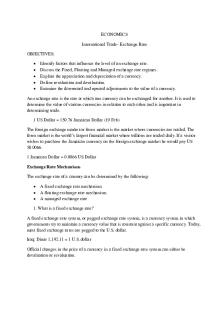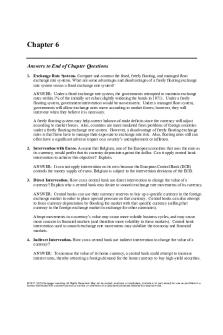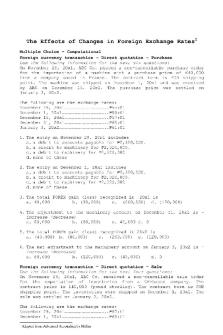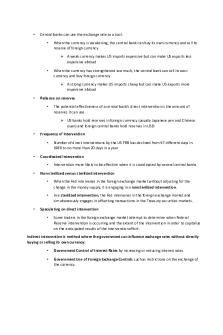Exchange Rates - Economics revision and helpful class notes PDF

| Title | Exchange Rates - Economics revision and helpful class notes |
|---|---|
| Course | Macro Economic Issues |
| Institution | University of South Wales |
| Pages | 4 |
| File Size | 119.8 KB |
| File Type | |
| Total Downloads | 55 |
| Total Views | 124 |
Summary
Economics revision and helpful class notes...
Description
Exchange Rates
SPICED WPIDEC
Government could shift AD down to AD1 by decreasing wages so people can’t afford as much. Also, by increasing income tax or increasing the exchange rates so it is cheaper to import. (Fiscal, monetary) This will affect BOP because a decrease in demand to below max output could put the country into a recession as they won’t be making enough money. Could also lead to a deficit. Decreasing the currency would mean it would be WPIDEC so exports would be cheap and imports are dear so if exports are higher than imports then the deficit will decrease. But, imports would also have to decrease more than exports increase to lower the deficit.
Deficit = -£200 million on current account BOP = SPICED, increased Is having a deficit bad? Yes -> fixing it could go wrong, better having surplus, not competitive, if one area of AD goes down, you are not going to be able to boost international competitiveness to boost AD again No -> balanced by surplus in capital/financial account, WPIDEC
Labour Productivity
SPICED Currency - fixed USA vs China
Economic growth achieved through using non-renewable sources Reaching YFE would reduce unemployment Jobs ↑ Money ↑ Tax ↑ Government Spending ↑ - Sustainability - Environment - Health -> healthcare -> negative multiplier - Productivity -> LRAS -> demand pull inflation
Economic Growth won’t last with non-renewable sources Economic growth achieved via non-renewable resources - Not good - If education it is good - If equal distribution of money is not apparent; bad
Benefits of Economic Growth:
Growth creates new jobs in the economy Higher real incomes -> higher living standards More tax revenues for the government Higher profits can fuel increased investment Rising wealth -> may be used to reduce poverty Increased funds available for infrastructure
AN: use graph + say benefits of it on the economy/country * If no country is given just link it back to question AN: GS ↑ = new jobs, education, training or technology * LRAS -> potential growth increases + decreases inflation / P ↓ IR ↓ gets you to YFE
T ↑ GS ↑ = multiplier and more jobs from government spending EVAL: if too much growth happened i.e. AD rises faster than AS = Demand pull inflation
Risk of Economic Growth:
Demand pull inflation Growth may be linked with rising inequality Risks of environmental damage costs Over-exploited of scarce finite resources Opportunity cost of increased capital investment Social problems arising from consumer society
EVAL: time lag -> slow -> demand pull inflation could happen in the long run AN: what is happening? -> effect of this? -> what does it depend on? -> bad, slag it off 1. Size of cut in IR 2. GS too much 3. Duration Inflation
Cost push inflation is where the prices and AD rise are controlled by cost so if goods cost more to produce then they will produce less and increase price. Supply has decreased so the price level has increased causing high levels of cost push inflation. If you decrease it, you will decrease economic growth to Y. Evaluation -
Demand pull inflation is where demand rises from AD to AD1 to increase output to the maximum potential but it keeps rising to AD2 so price rises from P to P1 then up to P2 as demand increases but supply cannot increase anymore as it is at its maximum potential output. This causes demand pull inflation as it means the
SPICED, make competitive so drop currency to WPIDEC, import prices up, country imports goods to make goods.
cost of these goods has to increase to deter people from demanding as much. Means currency is weak. This could then lead to interest rates increasing to lower spending or prices dramatically increasing but this could lead to a recession. Goods will become unaffordable so they will stop spending and it can reduce economic growth or lead to deflation. You could control this with an expansionary monetary policy so interest rates would go up and exchange rates could go up to get more exports/imports. Or, use fiscal policy and increase tax on goods or government spending so the company can produce more. Controlling this would cause a decrease in AD as you want it to fall so you are supplying enough but the same amount that is supplied is demanded. Benefits -> erodes debt, higher pay, economic growth....
Similar Free PDFs

Exchange Rates - economics notes
- 4 Pages

Inflation, Exchange & Interest Rates
- 14 Pages

Business Economics Revision Notes
- 41 Pages

Exchange Surfaces revision
- 9 Pages

03 Igcse economics revision notes
- 86 Pages

Economics revision - Grade: B
- 6 Pages

Economics - revision guide
- 14 Pages

Law and Economics Notes
- 97 Pages

Class-9-Economics
- 64 Pages
Popular Institutions
- Tinajero National High School - Annex
- Politeknik Caltex Riau
- Yokohama City University
- SGT University
- University of Al-Qadisiyah
- Divine Word College of Vigan
- Techniek College Rotterdam
- Universidade de Santiago
- Universiti Teknologi MARA Cawangan Johor Kampus Pasir Gudang
- Poltekkes Kemenkes Yogyakarta
- Baguio City National High School
- Colegio san marcos
- preparatoria uno
- Centro de Bachillerato Tecnológico Industrial y de Servicios No. 107
- Dalian Maritime University
- Quang Trung Secondary School
- Colegio Tecnológico en Informática
- Corporación Regional de Educación Superior
- Grupo CEDVA
- Dar Al Uloom University
- Centro de Estudios Preuniversitarios de la Universidad Nacional de Ingeniería
- 上智大学
- Aakash International School, Nuna Majara
- San Felipe Neri Catholic School
- Kang Chiao International School - New Taipei City
- Misamis Occidental National High School
- Institución Educativa Escuela Normal Juan Ladrilleros
- Kolehiyo ng Pantukan
- Batanes State College
- Instituto Continental
- Sekolah Menengah Kejuruan Kesehatan Kaltara (Tarakan)
- Colegio de La Inmaculada Concepcion - Cebu






